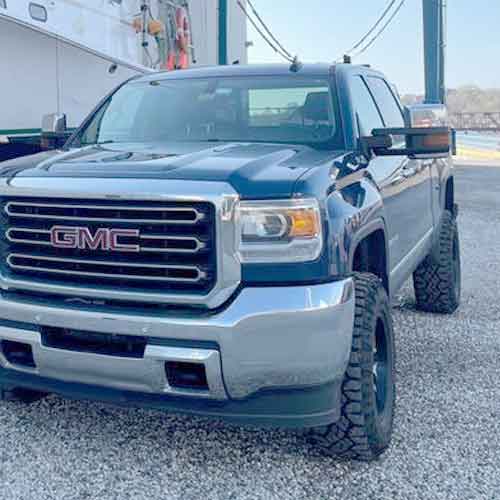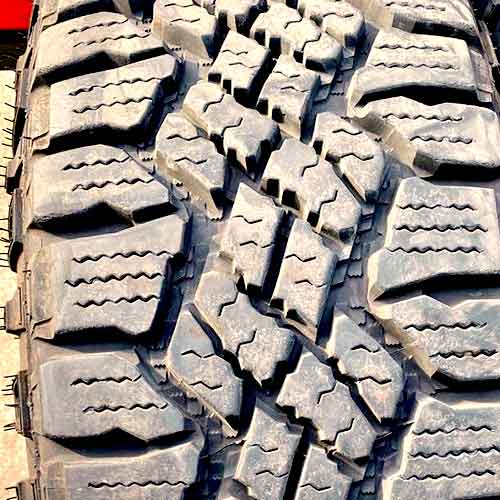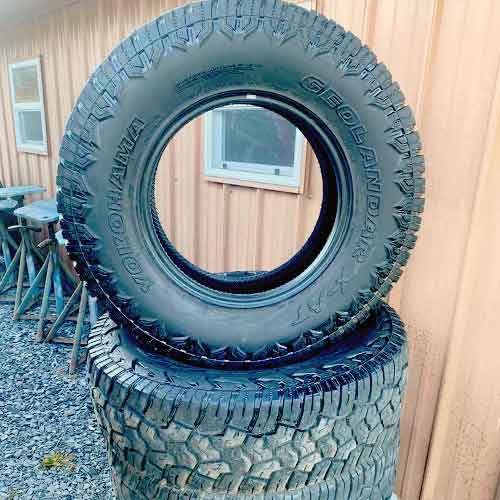Yokohama Geolandar X-AT and the Goodyear Duratrac are hybrid tires (also called rugged terrains). So these go a little more extreme compared to average all-terrain tires, which means they can pretty much handle anything off-road, even a little bit of mud. Yet, both perform very differently, let me give you a hint on their areas of expertise!

Being a tire engineer, my experience with these two, tells me that the Yokohama X A/T offers a superior off-road traction, especially when it comes to rock climbing and mud crawling, but it’s on road performance is a little off, and that goes for wet traction more. And that’s where Goodyear Duratrac comes in, with it’s full depth interlocking sipes providing ample traction. Though the tire is very loud, so comfort wise, it’s not going to impress that much.
Detailed Review of Goodyear DuraTrac: https://tiredriver.com/goodyear-wrangler-duratrac-review/
Detailed Review of Yokohama X-A/T: https://tiredriver.com/yokohama-geolandar-x-at-g016-review/
Sizes
Goodyear Duratrac Offers 15 to 22″ rim sizes with following features.
- Speed rating: Q, S, P, and T.
- Load rating goes up to F.
- Weight range: 35 to 68 lbs.
- Tread depth: 16/32″ to maximum 18/32″.
- 3PMSF and M+S winter ratings available on all sizes.
- 50k miles tread wear warranty (excluding LT sizes).
- LT sizes have stud-able lugs.
On the other side, the Yokohama Geolandar X-AT has sizes with 15 to 22 inches. And they have following specs.
- Speed ratings: Q (only).
- Load ratings: C, D, E and F.
- Weight range: 40 to 83 lbs.
- Tread depth range: 16 to 19/32″.
- 3PMSF/M+S Ratings Available.
- Warranty: 45k miles for all sizes.
- Only M+S available here.
Tread Structure
The Goodyear Duratrac has some amazing features, that aren’t see anywhere else.

Let’s talk about the most prominent one, it’s wider circumferential grooves, embedded with “Goodyear’s Tractive Groove Technology”.
These are basically planted biters in these grooves, a mini tread pattern, you can say, and they are very efficient in grabbing snow, ejecting debris, and breaking down mud particles (so they can escape out easily).
Containing these wild grooves are small “blocky” lugs (in the middle part of tread) with off-set edges, and zigzag sipes.
These edges promote off road bite, while the siping gives wet traction.
Moreover, like the shoulders, all these lugs are also joined up by reinforced foundational supports underneath.
On the other side, we have another hybrid terrain, the Yokohama Geolandar X-AT, designed to deliver superior performance on a variety of surfaces.

Let’s start things form sides.
Here, we have a staggered pattern, and a lot of biters on sidewalls (superior in comparison, I should add).
On shoulder lugs, there are deep slits, joining the rectilinear siping.
(The thicker slits are basically for winter traction, whereas thinner ones promote wet performance).
Moving towards middle, you see somewhat “L” and “S” shaped lugs there.
They are equipped with notches and similar siping pattern (as seen on shoulders).
Together, they make a better web of grooves, laterally joining the outer longitudinal channels.
Additionally, the shoulder lugs are equipped with stone ejectors in all directions, which further aids in removing any dirt or debris from the tread, quickly and efficiently.
Wet Traction
Wet grip is all about water removal, and that is done with sipes and grooves. Sipes basically provide wet (directional and lateral) grip, whereas grooves yield hydroplaning resistance.
In comparison, the Goodyear Duratrac offers better results as both its sipes and grooves yield superior efficiency.
Its siping have an interlocking design, so they remain flexible and helping that is its tread which is already pretty soft.
And it’s balder design along circumferential grooves allow ample water removal rate, so less it there for sipes to work on.
Yokohama X A/T on the other side, does not provide as much siping, and its lugs are closed up which hinders faster water removal, comparatively.
It’s sipes are basically rectilinear so, on corners, they tend to stiffen up, though you can say it’s good enough when it comes to overall hydroplaning resistance.
Dry Traction
Dry traction has to do with both directional and lateral grip.
The directional grip is achieved by the central lugs (on the tread), and here as the Goodyear Duratrac offers more packed up lugs, it allows for shorter braking distances.
The tire basically has a rounded contact patch, so it’s central lugs get to meet with more force, and with closed up placement there, it produces better results.
Yokohama X A/T basically does better with handling, lateral grip, and this has to do with its closed up shoulder lugs. Though it’s larger weight reduces the overall dynamic response times, that’ why it only comes in Q speed ratings, whereas the Goodyear Duratrac offers up to T.
Performance on Snow
Out of both tires, the Wrangler Duratrac is the only one with sever winter rating of 3 peak mountain snowflake, that’s why it’s not a surprise why this tire does better overall.
Though still, this rating is not everything as it just tells us about the acceleration factor (that it’s 10% better “in snow acceleration” compared to those which don’t have that).
So on lighter terrains, in handling department, the Yokohama X A/T actually does a better job, with its siping specially designed for it.
The thick sipes on its’ shoulder edges basically are made efficient in grabbing the snow particles and lodging them in, to make snow to snow contact.
Basically with weird arms of snowflakes, they stick better on each other, so this contact yields more desirable results of winter traction.
Rugged Tracks Traction
On rugged paths, each type of terrain needs a different set of skills, that’s why I analyzed both tires in all these land variations (at least those where I have experienced them tough).
Let’s dig in! (no pun intended).
On Sand
When it comes to sand, you need a lighter tire, having a lot of rubber, and durable rim locks.
With lighter construction, the tire does not dig in too much, whereas with a lot of tread, it gets to float better, with lowered air pressure.
And stronger rim locks ensure that you can safely drive with extremely low PSI value.
Yokohama Geolandar X-AT although offers a robust bead locker, the tire has more biting sides, and this combined with it’s heavier weight reaching up to 90 lbs, its simply does more digging.
Goodyear Wrangler DuraTrac on the other side, provides better results, with its smoother edges, as it makes smaller mud scoops, and it’s sidewall lugs are also designed in a way to allow it to have better flotation with lowered air pressure.
On Gravel and Dirt
In order to achieve better traction on gravel and dirt filled roads, tires need to have self cleaning grooves, and a cut resistant rubber.
Both tires have powerful cut resistant rubber lugs on top and they both are pretty self cleaning, though its surprising to see that Goodyear DuraTrac with such bolder tread voids is missing stone ejectors (at least conventional ones).
On the other side, the Yokohama Geolandar X A/T does a better job here as its shoulder lugs are surrounded with ejectors in all directions. So it’s able to keep its tread cleaner.
On Mud
Goodyear DuraTrac offers one of the top performing values on mud, at least in the A/T and R/T tires category.
It’s sharp biters in the middle are very efficient in slashing through the mud, breaking it down, and to further digest those particles, the tire’s mini biters in the grooves come in to action.
These mud particles then easily leave the tread, with the help of wide longitudinal grooves, connecting shoulder gaps.
On sides, you get efficient digging and scooping thanks to it’s staggered shoulders and sidewall lugs, these throw back the mud to provide forward momentum. And this way further traction is created.
On the other hand, the Yokohama Geolandar X AT although offers deeper tread voids, going up to 19/32″, it’s interconnected channel are not as effective in mud evacuation.
Moreover, there aren’t any biters, that can break down the thick slimy mud as well, so this tire lacks overall comparatively.
On Rocks
On rocks as you need durability along with biters, the Yokohama Geolandar X A/T does a better job overall.
It’s sidewall lugs are better optimized for this terrain and as they are pasted on a larger surface area, they promote superior overall footprint and lateral traction as a result.
Moreover, it’s 3 ply polyester casing makes it very resistant to punctures, allowing you to crawl on tougher paths with more confidence.
Goodyear Duratrac, in comparison, with weaker construction, and less flexing lugs can not provide as much traction compared to Yokohama.
Fuel Usage
How much fuel is being used is dependent on the rolling resistance of the tire. With more aggressive design, off road tires can’t be expected to perform super great in this department, though its better to know where they stand, as it matters in the long run. As a more fuel efficient tires technically pays for itself.
In order to find that, we have to consider the weight of the tire along with tread composition (the two main factors denoting rolling resistance).
And understanding both , it makes sense why Yokohama Geolandar X AT lacks comparatively.
With 3 ply sidewalls, this tire basically have a larger weight which then gets divided on a smaller tread area of lugs.
Moreover, with larger tread depth, and softer composition, a lot of energy gets wasted in to flexing these lugs, and less is consumed in to moving the tire as a whole
The Goodyear Duratrac on the other side, offers slightly smaller tread depth, and all it’s lugs have reinforced foundational supports which make a firmer contact with the ground, so less energy is being wasted here, and you get a direct steering response as well.
Tread Wear
How long a tread would last is although also dependent on rolling resistance, its not a major factor here. That’s because tread composition and depth can really change the overall game.
But none of these factors are helping Yokohama X A/T, as its softer rubber compound, having more weight simply burns off faster.
Goodyear Wrangler Duratrac on the other side, although is composed of a softer composition too, it’s still less susceptible to burning, as it’s enriched with Goodyear’s special Kevlar compound (though can’t reveal that here).
But let me tell you this, overall the difference is very low, and if you rotate these tires after every 4k miles, it can make the other tire better, that’s why Yokohama is only lacking with 5k in miles warranty.
Conclusion
Both hybrid tires are pretty great, but Goodyear DuraTrac lacks in the needed durability, that’s why its not so great on rocks. Though its pretty good when it comes to mud, as you get much better evacuation capabilities on this tire.
You also get a better design for highways as well in its case, though the tire is very loud.
Yokohama X A/T on the other side, provides superior comfort capabilities there combined with snow traction and with it’s 3 ply sidewalls, it lets you crawl on rugged tracks with more confidence.
Yokohama Geolandar is the idea choice for off-road purposes. Provides great comfort and ride quality, even on harsh and challenging routes such as slush, snow, gravel, or rocks.
Thanks for sharing